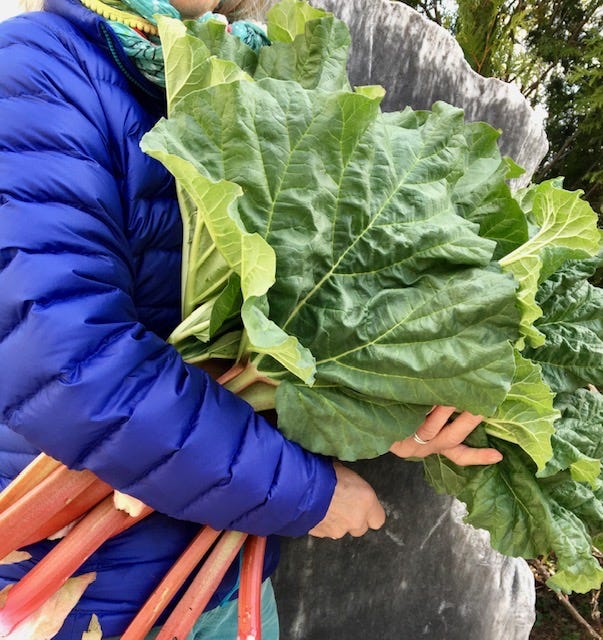Welcome to the Art of Growing Food newsletter. I write about artful growing tips for cooks who love to garden. You are receiving this newsletter because you are a free or paid subscriber. Thank you! - Ellen Ecker Ogden
Hello Everyone.
Like a well-synchronized orchestra, rhubarb and asparagus emerge as if on cue. The first rosy knobs of rhubarb push through the soil, followed by dramatic spears of asparagus. Both appear in perfect harmony with exquisite timing and singing it is Spring! Watching from the sidelines with excitement as the dramatic leaves unfold, and the green shoots appear like fireworks, all I have to do is sit back and wait for that first harvest.
Which I did this week, reveling in a dinner comprised of asparagus, and a dessert made with rhubarb. Both are generous plants and once the harvest season is done, they continue to push out ornamental foliage suitable for a kitchen garden or perennial border. No matter the weather, cold or warm, wet or dry, late season or early, these two perennial edibles are reliable and always in tune. Perfect harbingers of spring, they come back every year and keep the tempo rolling.
Many gardeners no longer include asparagus or rhubarb in a kitchen garden design, perhaps because it takes a bit of planning and ample space. Yet these two crops once found in every garden in New England and sometimes in the wild, are essential to an edible landscape. Besides, watching food grow is far more rewarding than buying it in the market. Rhubarb and asparagus are prepared to prove this is true. The first step is where to place the plants for longevity since both will be with you for a long time, maybe even after you have departed.
Asparagus can be especially tricky. It requires a south-facing garden bed, double-digging a deep trench, laying out the crowns in late winter or early spring, covering, watering, and waiting for up to five years. You can get named varieties, and breeders have improved the heirloom varieties to make them more reliable. Two decades ago, when I designed my kitchen garden I planted peonies where I should have planted asparagus. I often wonder if it is time to make the change.
Rhubarb is a good choice for that part of the garden that never gets full sun. The variety growing in my kitchen garden is an unnamed heirloom, left behind by the former owners. The rhubarb at my first house came the same way, it was just there. I often think rhubarb is like that stray cat or dog that will find you, and once you give it love and nurturing, is forever loyal and reliable. But if you leave your house and garden, you will have to leave it behind because of the long tap roots that prefer not to be disturbed once established.
Because rhubarb thrives at the shady end of the garden it creates a dark moist shade under the thick mass of leaves. It is the perfect habitat for toads and frogs, who eat the slugs and also love these conditions. Small children ( and big children) play with the large fronds like a parasol, and the seed heads make magnificent flower arrangements.
I suspect that rhubarb and asparagus are not as popular among gardeners because many use raised beds to contain their plants. This option limits the space for growing food and puts everything into a tight box. Unless you have grown up with a garden, or had a grandparent who grew asparagus and rhubarb, you may not even know the value of ornamental perennials and their contribution to the beauty and bounty of a gardenscape.
When including ornamental edibles in a kitchen garden, consider aesthetics in addition to harvest, because the two go hand in hand. Most are productive for a small window of the growing season and then stay green all summer. Perennial edibles can be grown in flower beds, alongside other perennials, yet fit best in the vegetable garden for convenience. Both asparagus and rhubarb require ample growing space, so do the research before devoting space to a single crop.
For pie, a single plant is all you will need for several desserts, with enough stalks to make a Rhubarb Crumb Coffee Cake. The recipe was shared years ago by a neighbor, quick to make for breakfast or snacking all day long. If you are growing, or have a source of fresh asparagus and wild mushrooms, here’s a recipe from my book. This spring, consider finding room to plant these good old friends, and once you taste that first green spear or bake a rhubarb pie, you’ll be glad you did.
From my garden to yours,
Ellen Ecker Ogden









Amazing looking rhubarb!
I used to live in a small town with a museum in the 19th century home of longtime residents. The kitchen garden was preserved and thriving along with shaded rhubarb plants and herbs like spearmint and lemon balm, and flowers like calendula, passionflower and wisteria. One year I was given permission to harvest some of those through the seasons. Rhubarb was a pleasant surprise hidden beneath a huge flowering shrub. I learned a lot about plants important to a 19th century housewife’s kitchen and medicine chest.